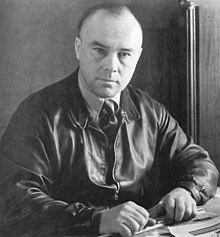Nikolai Nikolayevich Polikarpow
Nikolai Nikolaevich Polikarpov ( Russian Николай Николаевич Поликарпов ., Scientific transliteration Nikolai Nikolaevich Polikarpov * June 26 . Jul / 8. July 1892 greg. In Georgijewskoje in Livny , Oryol Governorate , † 30 July 1944 in Moscow ) was a Soviet aircraft designer.
Life
Polikarpow was born the son of a village pastor. After attending elementary school in Livny he attended high school in four years Oryol . After graduating, he studied mechanics at the Polytechnic Institute in Petrograd from 1911 and attended courses in aircraft and airship construction. After graduating in 1916, he became an engineer at the Russian-Baltic Airship and Aircraft Works ( RBWS ), where he had already worked on the side during his studies. Polikarpow was involved in the construction of the four-engine bomber plane Ilya Muromets .
In March 1918, he was recruited by the Central Air Force Administration of the newly formed Red Army and moved to Moscow. He was responsible for initiating series production of aircraft and setting up the necessary production facilities.
In August of the same year, Polikarpow switched to the Duks works (plant no. 1) as head of the technical office . At that time these were the largest Russian aircraft factories. There he was responsible for construction and material testing. At the end of the year the Duks R-1 , a replica of the De Havilland DH4, was ready to fly . In spite of an acute lack of engines, around 3,000 copies were built.
Polikarpow switched to the Technical Committee of the Air Force in 1919 and worked there on various committees. In January Polikarpow took over a design office, which consisted of the designers of the dissolved Duks works. A scaled-down version of the Duks R-1 was developed there and equipped with a powerful Liberty engine . The first in-house development of the design office was the Polikarpow I-1 fighter plane , a cantilever monoplane. Since Polikarpow was not a party member , he was released from his duties a short time later. In 1926 he was appointed head of a department for the design of fighter planes in the newly established Central Design Office (ZKB). The U-2 multi-purpose aircraft was developed at the ZKB in 1927 , with 40,000 units one of its most famous and most widely built aircraft types. After Polikarpov's death, it was renamed Po-2 in his honor.
Polikarpov was arrested in 1929 but was released in 1930. While in custody he developed the Polikarpow I-5 together with Dmitri Grigorowitsch . In the following years he also worked in Andrei Tupolev's OKB , until 1933 he founded his own experimental design office (OKB), where the I-16 , the first modern low-wing fighter with retractable landing gear, was built in the same year . In 1936 the OKB was relocated to aircraft factory No. 21 in Gorky .
In 1940 Polikarpow received his doctorate in technical sciences, in 1943 he became a professor at the MAI in Moscow, where he held the chair for aircraft design. During this time, the project for one of the first Soviet rocket planes , the Malyutka , arose , but was not pursued after Polikarpov's death.
In 1940 he was honored as a hero of socialist labor . He received the State Prize in 1941 and 1943. Polikarpov was awarded the Order of Lenin twice, once with the Order of the Red Star . Polikarpow designed around 70 types of aircraft.
Nikolai Nikolayevich Polikarpow died of stomach cancer in 1944. He was buried in Moscow's Novodevichy Cemetery. His tomb received an allegorical depiction of the falling Icarus , which was originally intended to be set up separately at a crossroads of the main paths of the celebrity cemetery.
literature
- Wilfried Copenhagen : Lexicon Soviet Aviation . Elbe-Dnjepr, Klitzschen 2007, ISBN 978-3-933395-90-0 .
- Heinz Machatschek: Personalities of Soviet aviation (3): N. N. Polikarpow and J. N. Andrejew . In: Flieger-Jahrbuch 85/86 . Transpress, 1984, ISSN 0428-5697 .
Web links
Individual evidence
- ↑ a b c Ulf Gerber: The great book of Soviet aviation 1920–1990 . Rockstuhl, Bad Langensalza 2019, ISBN 978-3-95966-403-5 , p. 332 .
| personal data | |
|---|---|
| SURNAME | Polikarpow, Nikolai Nikolajewitsch |
| ALTERNATIVE NAMES | Polikarpov, Nikolaj Nikolaevič; Поликарпов, Николай Николаевич (Russian) |
| BRIEF DESCRIPTION | Soviet aircraft designer |
| DATE OF BIRTH | July 8, 1892 |
| PLACE OF BIRTH | Georgievskoye, Oryol Governorate |
| DATE OF DEATH | July 30, 1944 |
| Place of death | Moscow |

